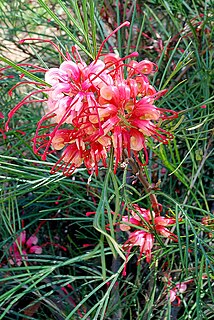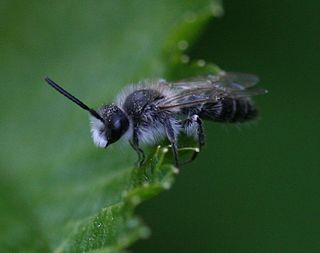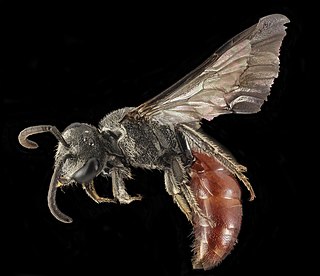
Halictidae is the second-largest family of bees. Halictid species occur all over the world and are usually dark-colored and often metallic in appearance. Several species are all or partly green and a few are red; a number of them have yellow markings, especially the males, which commonly have yellow faces, a pattern widespread among the various families of bees. The family is distinguished by the arcuate basal vein found on the wing.

Grevillea johnsonii, commonly known as Johnson's grevillea or Johnson's spider flower, is a species of flowering plant in the family Proteaceae and is endemic to New South Wales. It is a shrub with divided, needle-like leaves and red to orange flowers, and grows in rocky places.

Sphecodes is a genus of bees from the family Halictidae, the majority of which are black and red in colour and are colloquially known as "blood bees". Sphecodes bees are kleptoparasitic on other bees, especially bees in the genera Lasioglossum, Halictus and Andrena. The adults consume nectar, but because they use other bees' provisions to feed their offspring they do not collect pollen.

Sphecodes gibbus, the dark-winged blood bee, is a species of cleptoparasitic blood bee from the Palearctic. It is the type species of the genus Sphecodes and was first described by Carl Linnaeus as Sphex gibba in 1758.

Sphecodes davisii is a species of sweat bee in the family Halictidae.

Augochlorella is a genus in the bee family Halictidae, commonly called sweat bees. They display metallic coloration, ranging from reddish to gold to bluish green, as is typical for other genera in the tribe Augochlorini.
Sphecodes mandibularis is a species of sweat bee in the family Halictidae.

The bearded miner bee is a species of miner bee in the family Andrenidae. It is found in Europe and Northern Asia and North America. Other common names include the long-lipped andrena and the sandpit mining bee.

Sphecodes ranunculi is a species of sweat bee in the family Halictidae.
Sphecodes confertus is a species of sweat bee in the family Halictidae.
Sphecodes heraclei is a species of sweat bee in the family Halictidae.
Sphecodes aroniae is a species of sweat bee in the family Halictidae.
Sphecodes solonis is a species of sweat bee in the family Halictidae.

Agapostemon splendens, the brown-winged striped-sweat bee, is a species of sweat bee in the family Halictidae.

Anthophora urbana is a species of anthophorine bee in the family Apidae. It is found in Central America and North America.
The brown-tailed miner bee is a species of miner bee in the family Andrenidae. Another common name for this species the dark-tailed andrena. It is found in North America.

The eastern willow miner bee is a species of miner bee in the family Andrenidae. It is found in North America.
The shiny green miner bee is a species of miner bee in the family Andrenidae. Another common name for this species is the white-winged perdita. It is found in Central America and North America.

The Bradley's miner bee is a species of miner bee in the family Andrenidae. Another common name for this species is Bradley's andrena. It is found in North America.











